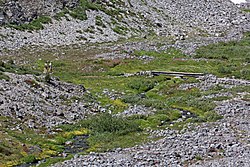This article needs additional citations for verification .(November 2025) |
| Paradise River | |
|---|---|
 Paradise River at the Skyline Trail Bridge | |
 | |
| Location | |
| Country | United States |
| State | Washington |
| Counties | Pierce County, Lewis County |
| Physical characteristics | |
| Source | Paradise Glacier |
| • location | Mount Rainier |
| Mouth | Nisqually River |
• coordinates | 46°45′52″N121°47′24″W / 46.76444°N 121.79000°W |
| Basin features | |
| Geographic Names Information System | 1533608 [1] |
The Paradise River is a small, short but swift river in Pierce County, Washington. It is the first major tributary of the Nisqually River. Located entirely within the bounds of Mount Rainier National Park, it is notable for its waterfalls, of which there are eight.